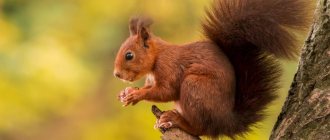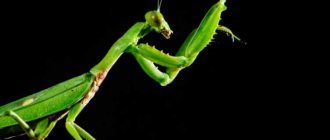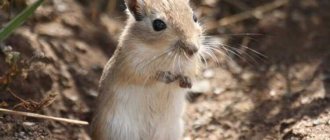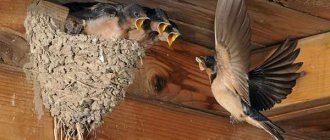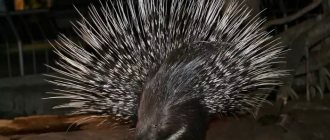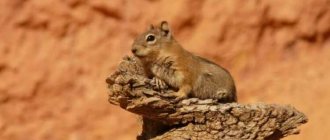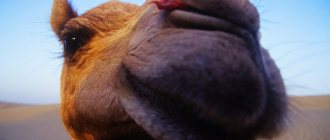Big-headed turtle (Platysternon megacephalum)
It is the only species of the genus of the same name from the family of snapping turtles. It got a rather strange appearance due to its long, snake-like tail, almost as long as its body. Habitat: Southeast Asia. The freshwater reptile cannot retract its large head into its shell, which is compensated by its very powerful jaws, so it is better to keep your distance from it. Able to climb trees, sitting on branches as a perch. Unfortunately, this species of reptile is endangered due to poaching.
Herbivores
These are the majority of land turtles:
- Central Asian;
- Mediterranean;
- Indian;
- Balkan;
- panther;
- Egyptian, etc.
95% of their menu is made up of food of plant origin: various weeds (clover, dandelions), vegetables and fruits. Therefore, they are herbivores that only occasionally consume animal food. In captivity, land turtles are given some boiled chicken eggs (whites only) for variety.
Venomtooth (Helodermatidae)
The only venomous lizard in the animal world, it is the largest in North America, usually reaching a length of more than 0.6 m. When disturbed, the reptile can fend for itself: the poisonous lizard grabs the legs or arms of its enemy, then plunges its teeth into them and quickly releases its extremely neurotoxic venom . Several deaths occurred after encounters with venom teeth until scientists were able to develop a treatment. These lizards do not have fangs, so they use enormous strength, slowly chewing a human hand and leaving behind flesh soaked in poison. If you immerse a reptile in water, there is a chance that it may release its prey. Representatives of the family of vultures are endangered and protected by law.
Reptiles attack: nothing frightens us more than the contact of modern man with poisonous snakes and prehistoric crocodiles. However, we will not talk about similar and well-known risks. In this list, we will look at the terrorist turtles and monster lizards that inhabit our land. Some of them are capable of killing, dismembering or simply chewing your limbs. Seeing a durable shell or a thin tail should tell you that this animal is worth fearing...
10. Common iguanas (lat. Iguana iguana)
Photo. Common (green) iguana
Today, iguanas have become very popular as pets, and animal lovers believe that this giant ancient reptile has become a better alternative to a dog. Although iguanas are herbivores, they are endowed with unpredictable personalities and are armed with incredibly sharp teeth. In some cases, people suffered horrific injuries when the supposedly tame but large iguana became angry and grabbed the faces of its owners, cutting the hand with its claws and teeth. Common (green) iguanas can weigh up to 7 kg and measure over 1.5 meters in length, which is why these huge lizards cannot be mistaken for a comic attack. You may well end up visiting the emergency room if you're attacked by this prehistoric creature.
Video. The most dangerous reptiles
It was recently reported that in the Cayman Islands, where green iguanas have become an invasive species, their numbers have grown to 1 million. Local authorities plan to slaughter 500,000 iguanas next year, so if you like these animals, hurry to the Cayman Islands.
9. Leatherback turtles (lat. Dermochelys coriacea)
Photo. Leatherback turtle
The largest turtles in the world are leatherback turtles, sometimes growing over 2 meters in length. These 2,000-pound creatures are omnivores and may be the most abundant vertebrate on Earth, but recently their ranks have been thinning and they are at risk of extinction due to industrial development, pollution and trapping. These turtles tend to act like gentle giants, but if disturbed they will bite your bones and have a very strong and crushing bite. In one bizarre incident, a huge leatherback turtle weighing over 1,500 pounds took out its aggression on a small boat and managed to sink it. This turtle had previously been chased by a shark, so it mistook the boat for a threat.
Leatherbacks travel farther than other turtles, migrating from Indonesia to Southern California, where they feast during jellyfish abundance in the summer and fall. Their numbers have declined in recent years due to illegal egg hunting, and adult turtles have been killed as hunting trophies.
8. Fringed turtles (lat. Chelus fimbriata)
Photo. Mata mata turtle
The Amazon is known for its amazing and sometimes dangerous animals. Fringeback turtles (Mata mata turtles) live in the river along with river dolphins and piranhas. It is not known what will happen if a person accidentally steps on a mata-mata turtle, but the unusual river reptile has an elongated snake-like neck with a bizarre mouth, in which there are two sharp plates, more reminiscent of human fused teeth. These especially dangerous predators choose fish, tadpoles, birds and other reptiles as their prey. One can only guess what will happen to a person who approaches the water’s edge...
The mata mata has few natural enemies, but people love to catch it, despite the unpleasant odor it emits. The main risks for this species are collectors and their disappearance from the habitat. The IUCN considers the fringe turtle population to be unthreatened, even though the last population count was in 1996.
7. Big-headed turtles (lat. Platysternon megacephalum)
Photo. Big-headed turtle
Big-headed turtles are oddly shaped turtles with a long, snake-like tail that reaches almost the length of the rest of their body. This turtle is native to Southeast Asia, where in rivers it pursues prey of varying weights and sizes. The turtle cannot pull its large head into its shell, and perhaps that is why it is equipped with very strong jaws. If the turtle feels threatened, it will use its bony beak without hesitation, so it is best to keep your distance. These turtles are able to climb trees, where they can build unique nests. It is sad that these amazing creatures are in danger of extinction due to poaching, so this activity needs to be fought more aggressively.
If you make her angry, she will bite and hold it for a long time. Strong hooked jaws can cause very serious injuries. This turtle is not known to be aggressive towards other turtles living with it.
6. Soft-bodied turtles (lat. Trionychia)
Photo. Great soft-bodied Cantora (lat. Pelochelys cantorii)
Looking like a flattened human-reptile hybrid, soft-bodied turtles make up for their shell deficiencies with an incredibly powerful bite. Among the wide variety of soft-bodied turtles, it is the large soft-bodied Cantor (lat. Pelochelys cantorii) living in China that is the most dangerous. She spends 95% of her life under sand or mud, leaving her eyes and nose on the surface, but as a predator, she has a good set of claws, a lightning-fast head and jaws strong enough to bite through bones!
The force of its bite and sheer size should tell you that an encounter with this turtle could result in horrific injuries. Unfortunately, today this species may become extinct, but a more numerous species of soft-bodied turtle, like the evil trionix (lat. Apalone ferox), is found all over the world and can bite an unwary fisherman.
5. Nile monitor lizards (lat. Varanus niloticus)
Photo. Nile monitor
Nile monitor lizards share the Nile River with other African river crocodiles and grow up to 9 feet in length. This terrifying lizard often eats young crocodiles as a change from its normal diet of birds and mammals, and is equipped with an unusually powerful infectious bite. If the Nile monitor feels threatened by humans or other potential intruders, it can grab the victim with an iron grip (bones may even be broken), which is very difficult to free itself from, since the lizard will not want to unclench its jaws.
Because they eat crocodile eggs, Nile monitor lizards are often seen near crocodile nesting sites. Adult monitor lizards can easily outrun a human at short distances. They can also stay underwater for more than an hour.
These giant lizards can often be seen sold as pets, but pet owners shouldn't take any chances with reports of deep injuries and the fact that these monitor lizards can "instantly break a cat's neck and then swallow it whole." Children are not recommended to be in close proximity, as it is impossible to exclude an attack by this predator.
4. Arizona snake teeth (lat. Heloderma suspectum)
Photo. Arizona snaketooth
Arizona gila monsters (Gila monster, vest) are the largest lizards in North America, which can reach more than 60 cm in length and are the only venomous lizards on the continent (there is another venomous lizard on Earth - the Komodo dragon). They get their name from the Gila River basin where they were first discovered. Arizona's vultures are threatened with extinction and are protected by American law, but if people decide to disturb them, they can even be fatal. If disturbed, the echinoderm can latch onto the arms or legs of an intruder, sinking its teeth in and instantly releasing a dose of unusually potent venom with neurotoxic effects. Several deaths occurred before the danger and treatment options became known. The lizard is not armed with fangs, but will hold on to a human hand with great strength, slowly chewing the flesh and leaving behind flesh saturated with poison. Submerging a vulture into water may force it to release and stop the carnage.
The bite is described as extremely painful, but the venom is not fatal to humans in most cases. According to the Arizona Poison Control Center, pain is typically felt in the area of the bite. It can also lead to swelling, nausea, vomiting, high blood pressure, weakness, dizziness, excessive sweating, chills and fever.
There is currently no antidote for an Arizona borer bite. The first step to treatment is to release the lizard. It is recommended to use a strong stick to push the reptile's jaws apart. First aid may involve flushing the wound with water and immobilizing the affected limb at the level of the heart. The wound should be cleared of broken teeth. Anyone who has been bitten by an Arizona dragonfly should immediately seek emergency medical attention.
3. Water monitor lizards (lat. Varanus salvator)
Photo. Water monitor
The water lizard (striped monitor lizard) is a lizard that is in second place by weight, after the Komodo dragon, and lives in the deep swamps and rivers of Southeast Asia. The monitor lizard has recurved teeth and is known to feed on dead bodies. If a living person falls into the water where a group of water monitor lizards are feasting, it is quite possible that, due to the person’s vulnerable position, the hunting instinct will be triggered, which will lead to an attack. Striped monitor lizards can feed on a variety of animals, having little trouble eating large prey. They gain 50 kg in weight and about 3 meters in length.
They are ubiquitous in mangrove forests and city parks throughout Malaysia. They are opportunistic scavengers, feeding on everything from dead fish to live birds, frogs and outdoor cats. They are not picky eaters and will eat almost anything.
“The water monitor can do a lot of damage, first with its tail and then with its teeth,” reports Dugusnel, who works with these monitors. “If someone tries to catch it, they could end up with a lot of stitches.”
2. Vulture turtles (lat. Macrochelys temminckii)
Photo. Vulture turtle
Snapback turtles are the world's largest freshwater turtles, and the most dangerous. Weighing in at over 200 pounds, this strange-looking reptile is covered like a dinosaur and has a massive beak capable of amputating any part of a human body with surgical precision, and can cut off a broom handle at breakneck speed. A person in the water walking near a turtle could easily lose part of his leg. Even though no deaths have been reported, it is possible for a person to drown without being noticed. One report reports a 400-pound turtle, which fits well with the species' constant growth throughout its life, which can last up to 200 years.
The snapping turtle actively hunts at night. During the day, it lies motionless at the bottom of the water and uses its worm-like appendage to attract prey. A snapping turtle can spend up to 40 minutes underwater without rising to the surface. Fortunately, these turtles have no natural enemies other than humans. Sometimes animals like snakes and raccoons will try to steal their eggs. Unfortunately, their meat and shell are sold at a high price and because of this, many of them die.
1. Komodo dragons (lat. Varanus komodoensis)
Photo. Komodo dragon
Komodo dragons inhabit the forested lowlands, plateaus and beaches of Indonesia, threatening almost every living creature as a prehistoric predator. Weighing 300 pounds and measuring 10 feet in length, these largest lizards on Earth form a prehistoric microcosm ruled by reptiles. Komodo dragons feed on buffalo-sized prey, and Komodo dragons have also been known to attack and eat humans. Such large reptiles are capable of knocking down their prey, and then brutally attacking and gutting a still living creature into large pieces of flesh. Bacteria and toxic saliva weaken the animal’s immunity, which does not die immediately. Scientists believe that Komodo dragons evolved and were able to feed on the now extinct pygmy elephants on the island.
To catch their prey, they use an ambush strategy. Combining well with dust and vegetation, they lie in wait for an unsuspecting animal passing by. They then quickly fly out from the ambush and deliver a venomous bite before the prey can escape. Then they follow the trail and find an animal weakened from the effects of poison and bacteria.
Unfortunately, people live among these lizards, which may mean they are feasting on recent burials. This has led people living on Komodo Island to move their graves from sandy soil to clay soil and place a pile of stones on top.
This entry was published on Thursday, November 23, 2022 - 16:25. You can leave a comment.
Leatherback sea turtle (Dermochelys coriacea)
The largest of all turtles: its length can reach 2.5 m and weight – 900 kg. Unfortunately, the population of these omnivorous creatures is declining. It is not recommended to disturb the tranquility of these rather gentle giants, as they are capable of breaking bones with one crushing blow. There was a case when one turtle barely broke away from the sharks pursuing it and sank a small boat that got in its way, perceiving it as a threat.
Types of turtles
You can't treat all turtles the same . It is recommended to feed exotic animals according to the type:
- Herbivores. Such turtles in nature feed on fruits, plants and vegetables, and in rare cases, lean meat.
- Predatory. They prefer fish dishes and vegetation.
- Omnivores. The daily diet is divided equally into protein and plant foods.
A properly formulated diet is considered an important condition for an animal’s well-being. If you choose the wrong products, diseases of the digestive system will occur.
If you liked the video, share it with your friends:
Herbivores exotic animals
Land, Mediterranean and Central Asian turtles are called herbivores. At home, they eat food of plant origin. The basis of the daily menu (80%) is cabbage and lettuce leaves, various herbs and dandelion greens.
A small part (15%) of the diet is cucumbers, tomatoes, zucchini, fresh and boiled carrots. The remaining 5% are bananas, berries, juicy pears and apples.
Once every seven days, be sure to give a well-cooked egg. Snails, slugs and large insects are added monthly . It is recommended to supplement the diet with the following products:
- mushrooms;
- peas, sorrel, timothy, lawn grass, thistle leaves, clover, sprouted oats, coltsfoot and speedwell;
- tangerines, apricots, oranges, mangoes, raspberries, blackberries and strawberries;
- sweet peppers, green onions and carrots, squash, horseradish, artichoke, legumes and beets;
- bran, raw sunflower seeds, dry yeast and seaweed.
If you liked the video, share it with your friends:
For dietary diversity, experts advise using food for land breeds. Manufacturers offer them along with various vitamin supplements.
Reptile predators
The basis of the daily diet of turtles of the predatory type - aquatic, red-eared and swamp - includes low-fat river and sea fish (hake, cod, pollock and navaga). As well as chicken and beef liver, fresh or boiled.
Once a week, fish with crushed backbone is added to the menu. Young turtles are advised to chop it into small pieces.
In addition to basic nutrition, predators are fed with plants, juicy fruits and fresh vegetables. The following is suitable as an addition to the main menu:
- raw seafood (shell shrimp, oysters, mussel and octopus tentacles, squid);
- frogs, crabs, food mice and laboratory rats;
- snails, pond snails, coils and ampularia;
- insects (beetles, cockroaches, bloodworms, wood lice, tubifex worms, mealworms and earthworms).
Common turtle (Macroclemys temminckii)
The largest freshwater turtle on Earth, and by far the most dangerous. The more than 90-pound reptiles are covered in a spiked shell much like dinosaur skin and have a massive beak that can be used to bite off any part of the body. A swimmer who accidentally steps next to you can easily lose part of his leg. Individuals of this species grow throughout their lifespan (which can reach 200 years), so adult snapping turtles can reach a weight of about 180 kilograms.
Carapace
If you look at a photograph of a turtle, its main feature is its shell. This reliable device serves as a defense for the animal from external stimuli that pose a potential danger. It protects both from the back and the belly.
Sensing an approaching predator, the turtle can completely hide in it and remain out of reach. Experimentally, it was found that the shell can support a weight exceeding the mass of the reptile by 200 times.
Large softshell turtle (Pelochelys bibroni)
What it lacks in shell it makes up for with a powerful bite. The most terrible individuals - the giant soft-bodied Cantor turtles - are common in China. Hiding in the sand, they wait for their prey and then strike it with their sharp teeth. Due to its enormous size and bite force, it is a real threat to the unwary person. Unfortunately, this reptile species is endangered.
Common iguana or green iguana (Iguana iguana)
Despite the fact that this reptile is a herbivore, it nevertheless has sharp razor teeth and can be quite unpredictable. A number of cases have been recorded in which owners keeping “tame” iguanas at home received rather severe injuries: when excited, the animals rushed into their faces, tearing the skin with their claws and teeth. Some representatives of this class of reptiles can reach 18 kilograms in weight and 2 meters in length, thereby representing a creature that it is better to try to avoid meeting.
Tornado Worm
In March of this year, residents of New Jersey were hit by a tornado, which many residents called “the harbinger of the end of the world.” The fact is that the main participants in the disaster were worms, which probably crawled out the night before after the rain. Is this a coincidence, an indication of the direction of the water flow, or a frightening omen? Who knows.
We also talked about why the path of a tornado is difficult to predict.
Photo: livescience.com
Fringed turtle, or Mata-Mata (Chelus fimbriatus)
These creatures live in South America, in river basins from the Orinoco to the Amazon, sharing water space with river dolphins and piranhas. What will happen to a person who is unlucky enough to step on it is unknown, but this reptile with a bizarre appearance has an elongated snake-like neck and a strange mouth filled with two sharp plates reminiscent of fused human teeth. The unusually creepy carnivores hunt waterbirds, fish and other reptiles.
Habitat
All turtles can be divided into sea and land turtles. Terrestrial includes land and freshwater species. The habitat mainly depends on the type of turtle. Sea turtles live in the seas and oceans, land turtles live on land, and freshwater turtles live in bodies of water located near land.
What all turtles have in common is that they live only in temperate and tropical climates. In those regions where the air temperature drops below 18 degrees, turtles hibernate. They remain in a state of suspended animation until the air warms up to 15 degrees and above.
Komodo dragon (Varanus komodoensis)
It lives on the beaches, plateaus and woodlands of the Indonesian islands, being a threat to almost every living thing, like a prehistoric predator. Komodo dragons reach a length of 3 meters and weigh about 136 kg, being the largest lizards on the planet. This type of reptile feeds on buffaloes and can attack and eat people: knocking down large prey, these monsters then attack, tearing off large pieces of flesh. With their toxic saliva and bacteria, they weaken the prey, which does not die immediately. According to scientists, Komodo dragons evolved to feed on the already extinct dwarf elephants of Komodo Island.
Dream Interpretation - Dog
In general, a dog in a dream means a friend - good or bad - and is a symbol of love and devotion. Seeing her in a dream foretells receiving news from a friend or meeting him. Small dogs in a dream mean troubles, worries, vanity. A black dog in a dream means your friend who has started something against you. A white dog in a dream is your close friend. A red dog in a dream means a very close person, husband, wife, lover. The breed and size of a dog in a dream characterizes your friends. A poodle, Spitz and other decorative dogs in a dream are a faithful and gentle friend. A dog in a dream is a big and smart friend. But if in a dream he bares his teeth at you, then beware of him. This is no longer a friend, but an insidious enemy. Hounds and hunting breeds in a dream mean selfish people who will not hesitate to make money from you or deceive you for profit. But if in a dream you know that you have hunting dogs, then the dream predicts good luck or profit for you. If dogs are chasing you in a dream, then you should be wary of traps prepared for you by insidious enemies. Guard dogs are loyal, devoted and strong friends who are ready to protect you in difficult times. Meeting a dog in a dream means receiving news from a loved one or friend. A playing dog in a dream is a harbinger of a joyful or pleasant meeting. An affectionate dog means a devoted friend. However, if in a dream an unfamiliar dog caresses you, then you should be wary of deception or betrayal. Petting a dog yourself in a dream is a sign that you are trying to win the favor of a loved one. A snarling, barking, growling, attacking dog in a dream predicts quarrels, scandals, and insults. If you dream that a dog has bitten you, then you should not lend money to your friends, so as not to quarrel with them later because of this. Sick dogs in a dream symbolize a decline in business or the loss of some property. If in a dream you see that a small dog is sick, then sadness and disappointment await you. A dream in which you saw that a dog is hiding from you, avoiding you, or running away from you, portends a breakdown in your relationship with a close friend and his cooling towards you. Hearing a loud bark in a dream is a harbinger of success in business. If barking scared you in a dream, then the news will be unpleasant. Hearing several dogs barking in a dream means a big scandal or trouble. If you dream that some big red dog had an accident, as a result of which it died, then you will soon learn about the sudden death of a loved one who will die as a result of a similar accident. Gnawing dogs in a dream means a quarrel with a loved one. If you dream that your dog is chained or collared, then know that your friend is not free from any obligations and you cannot count on his loyalty. If in a dream you manage to unhook the leash and remove the dog’s collar, then success in your personal life and victory over your rivals awaits you. A beautiful white dog in a dream foretells receiving good news from a loved one. A dirty, wet, unkempt white dog in a dream is your close friend who, because of you, got into an unpleasant situation and had a lot of trouble in his family. Angry dogs in a dream are your enemies. A mad dog in a dream is your fierce enemy. Often such a dream predicts that you will experience shame or humiliation caused by unfounded accusations. A doghouse in a dream is a harbinger that you will soon find yourself in cramped circumstances and will be forced to reckon with it. Riding a dog in a dream means the strength of your position and good luck in business. Dogs fighting among themselves are rivals. Walking with a dog in a dream is a sign of a pleasant time with your loved one. If in a dream a dog protects you from enemies, then know that you have a friend whose help you can count on. See interpretation: animals.
Malayan water monitor (Varanus salvator)
The second heaviest lizard on the planet. It lives in the deep waters of rivers and swamps in Southeast Asia. The reptile has curved teeth and will not refuse to eat corpses, in addition to a wide variety of invertebrate and vertebrate animals. A person falling into water in which several monitor lizards are feeding at once can awaken their hunting instinct and provoke their attack. Typically, Malayan water monitors reach a length of up to 3 meters, while weighing about 70 kilograms.
Time and process of feeding
Turtle activity peaks during the daytime. During these hours you can feed them. If you give food in the evening, then certainly 3 hours before bedtime.
Pet turtles can go without food for two days, but regular proper nutrition is recommended for a healthy pet. When hungry, the exotic animal actively examines the bottom of its home in search of food. It is important not to miss these signs and feed the turtle on time.
If your pet refuses to eat for a long period of time, it is recommended to consult a specialist. The pet, which has not yet had time to adapt to new conditions, also loses its appetite.
It happens that an animal needs a change in diet , in which case a quick transfer to another food is unacceptable. Correct replacement takes place within 14 days.
If you liked the video, share it with your friends:
If two or more turtles of different ages live in the same aquarium, it is necessary to control the moment of eating. Each animal must receive the right amount of food.
Adult land animals require one meal a day, and young ones require two meals a day. It is recommended to unload once every 10 days. To properly eat, the turtle is taught to eat with tweezers.
At home, it is recommended to feed aquatic turtles by adding food to the aquarium. At the same time, the quantity is controlled to avoid clogging the home.
Many people prepare food at home by finely grinding a set of products in a blender or meat grinder. Store the prepared mixture in the refrigerator, warming the required amount to room temperature.
Be sure to carefully study the composition of the finished diet for the turtle, since large amounts of fishmeal, dyes and preservatives are harmful to the pet.
If you liked the video, share it with your friends:
